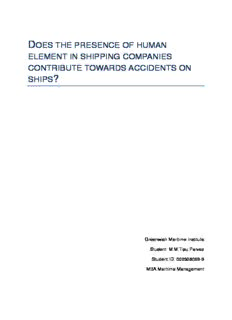
does the presence of human element in shipping companies contribute towards accidents on ships? PDF
Preview does the presence of human element in shipping companies contribute towards accidents on ships?
D OES THE PRESENCE OF HUMAN ELEMENT IN SHIPPING COMPANIES CONTRIBUTE TOWARDS ACCIDENTS ON ? SHIPS Greenwich Maritime Institute Student: M.M.Tipu Parvez Student ID: 000528069-9 MBA Maritime Management Declaration I hereby declare that this work has not been previously accepted in substance for any degree and is not being concurrently submitted by another candidate for any degree. I further declare that this dissertation is being submitted in partial fulfilment of the requirements for the degree of MBA in Maritime Management and it is the result of my own independent work except where otherwise stated. Other sources are acknowledged by explicit references. A bibliography is appended. Finally, I hereby give consent for my dissertation to be available for photocopying and inter library loan, and for the title and abstract to be made available to outside organisations. i Acknowledgement I humbly thank the Lord Almighty for His grace and mercy that enabled me in completing this research in good faith. I would like to express my gratitude to Dr. Minghua Zhao for her support and guidance in this research. This research became a reality because of the continual support from Maritime and Coast Guard Agency, especially Mr. David Turner and for that I shall be ever grateful. A special thanks to a dear friend and for all those who helped me in this research. I would like to thank my wife and my family for their support and encouragement. I dedicate this research to my beloved parents, „thanks a lot‟. ii Abstract This research studies the current knowledge on human element and applies them to a manager in a shipping company. The aim of this research is to identify human elements in a shipping company and to understand how decision-making and safety culture are affected by human behaviour. It is further hypothesised that the presence of human element in a shipping company can lead to accidents on ships. The research adopted a positivist paradigm and followed a survey methodology. A total number of forty one questionnaire responses were received and two interviews were undertaken taken. The findings of the research were considered rich and unbiased because the analysis was carried out taking into account the perspective of managers, seafarer‟s and the wider industry. The present research indentified decision-making and safety culture as factors which are affected by human behaviour. The results also identified a degree of variance in the industry with respect to safety. There was a group who adhered to the best practices and, is referred as the „exemplary group.‟ Whereas, evidence also identified a group which was in contrast to the earlier and is referred as the „atypical group.‟ Other significant findings of the present research were, A high degree of variance was observed for the training of managers while dealing with safety related issues; As compared to managers seafarers were not being involved in developing a safety policy; Deliberate violations on part of management when onboard safety procedures were by passed and; Wrong decisions made by managers can lead to accidents on ships. iii In light of the literature review and the findings the research concludes that presence of human element in a shipping company can lead to accidents on ships. Furthermore, the research draws attention towards the price of not addressing the human element. For it comes not only in form financial losses but, the introduction of new laws such as MLC – 2006, The Companies Act 2006 and The Corporate Manslaughter and Corporate Homicide Act 2007 are compelling evidence that companies are required to act in a responsible manner or else they will be accountable for their action. iv Table of Contents Declaration ........................................................................................................................... i Acknowledgement .............................................................................................................. ii Abstract .............................................................................................................................. iii List of diagrams .................................................................................................................. v List of graphs ..................................................................................................................... vi List of tables ...................................................................................................................... vii List of Abbreviations ....................................................................................................... viii CHAPTER ONE .................................................................................................................... 1 Introduction ......................................................................................................................... 1 1.1) Back ground to study: ............................................................................................. 1 1.2) Aim and objective:................................................................................................... 2 1.3) Research question: ................................................................................................. 3 1.4) Hypothesis: ............................................................................................................. 3 CHAPTER TWO ................................................................................................................... 5 Literature review ................................................................................................................. 5 2.1) By the people for the people ................................................................................... 5 2.2) Journey of human element ...................................................................................... 7 2.3) Human Element is drawing attention ....................................................................... 9 2.4) What is the definition of Human Element? ............................................................ 15 2.5) Accidents .............................................................................................................. 17 2.6) Human Element is every where ............................................................................ 22 2.7) The Company ....................................................................................................... 24 2.8) Decisions .............................................................................................................. 28 2.9) Safety culture ........................................................................................................ 32 CHAPTER THREE ............................................................................................................. 35 Methodology...................................................................................................................... 35 3.1) Positivist paradigm: ............................................................................................... 35 3.2) Methodology: ........................................................................................................ 36 3.3) Data collection: ..................................................................................................... 37 3.4) Population and sample: ........................................................................................ 38 3.5) Data analysis: ....................................................................................................... 39 3.6) Ethics: ................................................................................................................... 39 CHAPTER FOUR ............................................................................................................... 41 Results ............................................................................................................................... 41 4.1) Analysis of results: ................................................................................................ 43 CHAPTER FIVE .................................................................................................................. 82 Managerial importance of the research ........................................................................... 82 5.1) Companies Act 2006 (CA): ................................................................................... 82 5.2) Corporate Manslaughter and Corporate Homicide Act 2007: ................................ 82 5.3) Merchant Shipping Act 1995: ................................................................................ 83 5.4) Financial Losses: .................................................................................................. 83 CHAPTER SIX .................................................................................................................... 85 Conclusion and Recommendations ................................................................................ 85 References ........................................................................................................................ 88 Annexes ........................................................................................................................... 114 Annex A: Ethical letter ................................................................................................ 114 Annex B: Manager‟s questionnaire ............................................................................. 115 Annex C: Seafarers questionnaire .............................................................................. 120 Annex D: Interview questions ..................................................................................... 126 List of diagrams Diagram 1: Factors related to human error ...................................................................................... 2 Diagram 2: Human Element ............................................................................................................. 22 Diagram 3: Organisational chart ...................................................................................................... 26 Diagram 4: Organisational chart ...................................................................................................... 26 Diagram 5: Swiss Cheese model of accident causation .............................................................. 30 Diagram 6: Balancing between safety and profits ......................................................................... 31 v List of graphs Graph 1: Number of ships subjected to IMO conventions lost .................................................... 17 Graph 2: Merchant vessels in accidents (1997-2009) .................................................................. 18 Graph 3: Merchant Vessels in Accidents (1997-2009) ................................................................. 19 Graph 4: Merchant Vessels in Accidents (1997-2009) ................................................................. 19 Graph 5: Merchant Vessels in Accidents (1997-2009) ................................................................. 20 vi
Description: